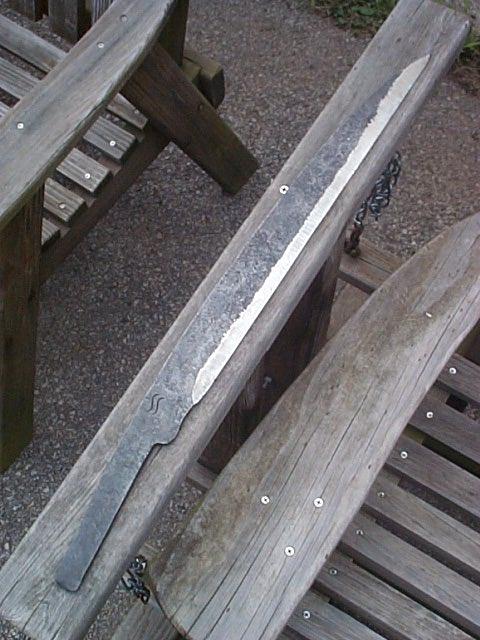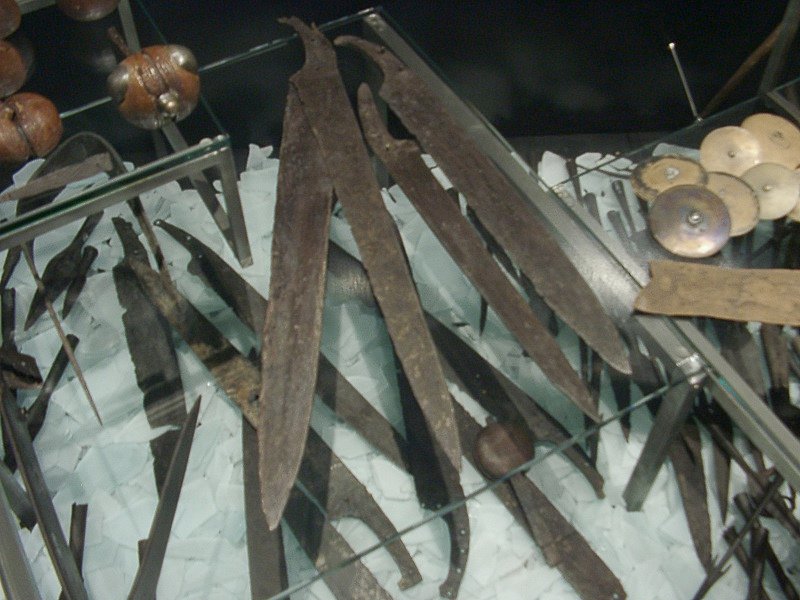
| myArmoury.com is now completely member-supported. Please contribute to our efforts with a donation. Your donations will go towards updating our site, modernizing it, and keeping it viable long-term.
Last 10 Donors: Anonymous, Daniel Sullivan, Chad Arnow, Jonathan Dean, M. Oroszlany, Sam Arwas, Barry C. Hutchins, Dan Kary, Oskar Gessler, Dave Tonge (View All Donors) |
| Author |
Message |
Sam Salvati

|
 Posted: Fri 03 Aug, 2007 9:43 am Post subject: Historical Seax? Posted: Fri 03 Aug, 2007 9:43 am Post subject: Historical Seax? |
 |
|
Hello, long time lurker first time poster. Would this be considered a historical seax shape?
 Attachment: 64.41 KB Attachment: 64.41 KB

I've got a lust for life
|
|
   |
 |
|
Mike Arledge
|
 Posted: Fri 03 Aug, 2007 9:53 am Post subject: Posted: Fri 03 Aug, 2007 9:53 am Post subject: |
 |
|
Sam,
So you are over here too? Coolness. I am interested in this opinion as well, as this seax is a commission for myself. Sam rocks to all here who are new to his work!
Mike J Arledge
The Dude Abides
|
|
   |
 |
Ville Vinje

|
 Posted: Fri 03 Aug, 2007 10:46 pm Post subject: Posted: Fri 03 Aug, 2007 10:46 pm Post subject: |
 |
|
|
A seax has a triangular cut though section, looks like this one has a traditional shape with a flat blade and a sharpened edge.
|
|
   |
 |
Patrik Erik Lars Lindblom

|
 Posted: Sat 04 Aug, 2007 1:24 am Post subject: Posted: Sat 04 Aug, 2007 1:24 am Post subject: |
 |
|
 As Ville says and .........here can you see hove the tang looks like, page 25 in this pdf - file. As Ville says and .........here can you see hove the tang looks like, page 25 in this pdf - file.
Frid o Fröjd!
Patrik
|
|
  |
 |
|
Jeroen Zuiderwijk
Industry Professional
|
 Posted: Sat 04 Aug, 2007 12:33 pm Post subject: Posted: Sat 04 Aug, 2007 12:33 pm Post subject: |
 |
|
|
Saxes are particularly difficult to do historically correct, in particular if you haven't studied many of them in great detail. So if you don't copy one in every detail, it's generally going to be far off compared to the originals. Compared to saxes in general, the tang is very different, and as Ville noted, seaxes generally have triangular cross-sections, without and secundary bevels. Some have cross-sections, which start flat and curving down towards the edge, but these are broadsaxes. These have very thick (9-10mm) broad and relatively short, heavy blades. In terms of the tangs, these were generally quite long, and glued into a long wooden haft (frequently 18-20cm at least, judging from the remaining lengths), in particular with broadsaxes and longsaxes. Some saxes have metal hilt components (pommels, bolsters). These are generally narrowsaxes, which are earlier then the broadsaxes and langsaxes. These saxes with metal pommels etc. generally had decoration chisels in the blades, in the form of braids, snakes etc.
|
|
   |
 |
Sam Salvati

|
 Posted: Mon 06 Aug, 2007 6:36 pm Post subject: Posted: Mon 06 Aug, 2007 6:36 pm Post subject: |
 |
|
Good to know, thanks alot guys. I didn't go with a through tang, as I am not too proficient yet with it, and it needs to be super tough so we are going with slab handles on it, not historical but super tough.
I've got a lust for life
|
|
   |
 |
Martin Wallgren

|
 Posted: Tue 07 Aug, 2007 2:49 am Post subject: Posted: Tue 07 Aug, 2007 2:49 am Post subject: |
 |
|
| Sam Salvati wrote: | | Good to know, thanks alot guys. I didn't go with a through tang, as I am not too proficient yet with it, and it needs to be super tough so we are going with slab handles on it, not historical but super tough. |
Have you seen the danish bogfinds where there is examples of earlier seaxes? heres a pic...
 Attachment: 98.94 KB Attachment: 98.94 KB

Swordsman, Archer and Dad
|
|
    |
 |
Sam Salvati

|
 Posted: Tue 07 Aug, 2007 12:21 pm Post subject: Posted: Tue 07 Aug, 2007 12:21 pm Post subject: |
 |
|
AHH EXCELENT! Now I know what people meant when they said "banana shaped handles", thank you very much.
I've got a lust for life
|
|
   |
 |
|
|
You cannot post new topics in this forum
You cannot reply to topics in this forum
You cannot edit your posts in this forum
You cannot delete your posts in this forum
You cannot vote in polls in this forum
You cannot attach files in this forum
You can download files in this forum
|
All contents © Copyright 2003-2024 myArmoury.com — All rights reserved
Discussion forums powered by phpBB © The phpBB Group
Switch to the Basic Low-bandwidth Version of the forum
|

